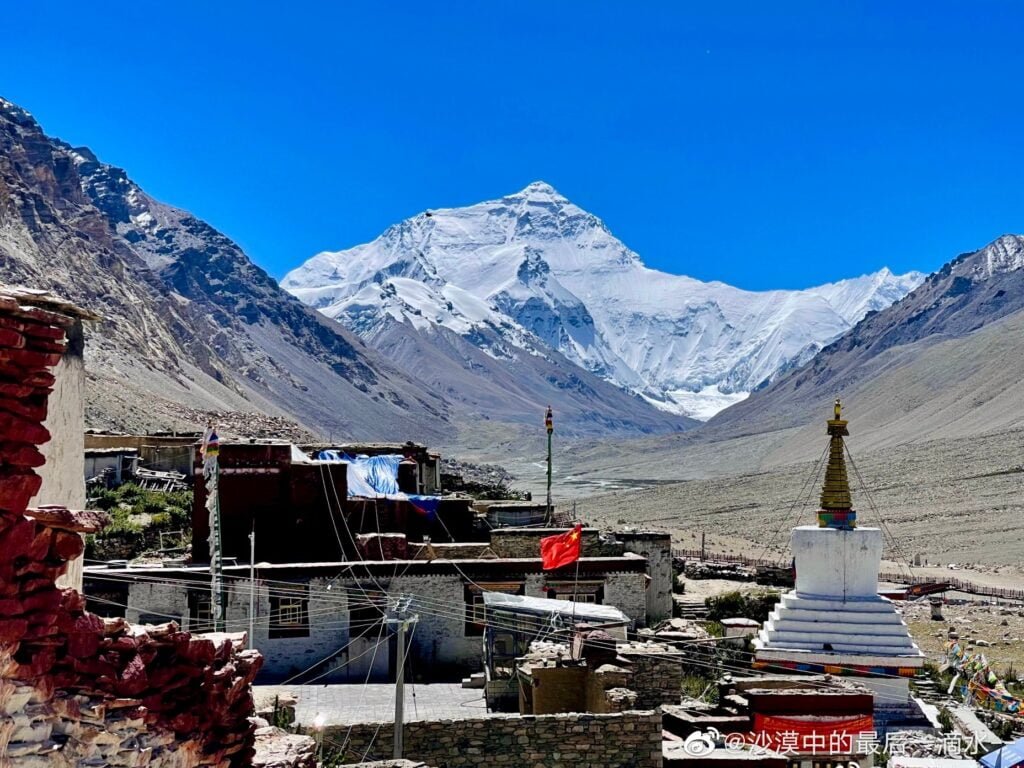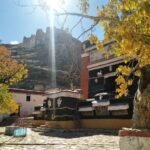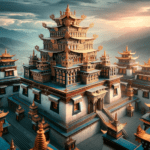A Sacred Sanctuary at the Foot of Mount Everest
Rongbuk Monastery, and officially “རྫ་རོང་ཕུ་དགོན་,” translates to “Valley Nook Monastery” in Tibetan. The term “绒布寺” has been used in Chinese translations. Positioned on the slopes of “Drolma” or Tara Mountain, south of Basum Township in Tingri County, Shigatse, Tibet, it lies beneath the towering majesty of Mount Everest. At an elevation of 5,154 meters, it holds the title of the world’s highest monastery, a place where the spiritual realm meets the harsh, beautiful extremes of nature. For centuries, the Tibetan people have revered Everest as a deity, with famous spiritual figures like Milarepa, a pioneer of the “do” song genre in Tibetan literature, having meditated in caves around the mountain for nine years, leaving behind a legacy of captivating stories.

The Foundation and Evolution
Founded by the red-hat Lama Ngawang Tenzin Norbu in 1899, Rongbuk Monastery is a beacon of the Nyingma sect of Tibetan Buddhism. It’s a distinctive monastery where monks and nuns live together, embodying a rich tapestry of local traditions. The monastery comprises both old and new sites, with the older section located 3 kilometers south of the new site, closer to Everest, preserving the meditation cave, hand and footprints, and stones and stupas associated with Padmasambhava.
Constructed in 1902, the new monastery once boasted a larger scale, including over a dozen subordinate monasteries, some even extending into Nepal, though many were destroyed. Today, beneath the main monastery lie eight smaller monasteries and a nunnery. The Rongbuk Monastery we see today emerged after renovations that began in 1982, carefully designed to follow the mountain’s contours.
A Sanctuary Amidst the Glaciers
Perched between 5,300 to 6,300 meters on the north side of Mount Everest, the Rongbuk Glacier is formed by the confluence of the West, Middle, and East Rongbuk Glaciers. Stretching 26 kilometers long, it acts as a massive “natural solid water reservoir,” with a total water storage exceeding 16 billion cubic meters.
At the foot of Rongbuk Monastery, meltwater from the Rongbuk Glacier flows by. Beyond the main temple complex, the monastery comprises eight smaller temples, including a nunnery, sprawling across over 10,000 square meters with more than 300 rooms. The monastery itself is a five-tiered structure, though currently, only two tiers are in use.
Both monks and nuns participate in Buddhist rituals here. In its prime, the monastery was home to more than 300 monks and nuns and housed over 20 temples. Presently, it shelters 11 monks and 8 nuns, with a chanting hall and a temple, venerating figures such as Sakyamuni and Padmasambhava, and often visited by Nepalese pilgrims. By the time of Tibet’s peaceful liberation, Rongbuk Monastery was under the stewardship of its 12th reincarnated lama.

The Mythical Lore
During Songtsen Gampo’s reign, people called the region “Lozha Malang,” which means “The Land Where Birds Are Reared” in the Himalayas. King Trisong Detsen, aiming to spread Buddhism in Tibet, invited Guru Rinpoche (Padmasambhava) for this purpose. The practice of worshipping the “Five Sisters of Long Life,” goddesses that the Everest and its surrounding peaks represent, demonstrates the deep spiritual roots of the area. Tibetans consider Everest, or “Chomolungma,” meaning “Goddess Mother of the World,” as the most beautiful among these goddesses. Her sisters protect and nurture her, symbolizing fertility and protection.
The Depiction of Divine Femininity
In Tibetan Buddhist art, such as in Rongbuk Monastery, the goddess of Everest is often portrayed in white, riding a white lion, with a golden vajra scepter in her right hand and a long treasure vase in her left, symbolizing her majestic and protective nature. This representation of the divine feminine, nurturing the land with snowmelt and sowing the seeds of life, is a profound expression of reverence and adoration by the Tibetan people.

Architectural and Cultural Highlights
A modest entrance leads visitors up a six-step stone staircase into a courtyard, centered around a towering prayer flag pole. The main structure features a chanting hall and a Buddha hall across two utilized floors of a five-story building. At its zenith, Rongbuk housed over 300 monks and 300 nuns, along with more than 20 temples and a chanting hall. Currently, it is home to over 40 monks and nuns.
The temple’s doors are adorned with lavish decorations, including gilded cloud motifs, mythical creatures at the corners, and copper bells at the eaves. The hall houses protective deity statues, with the main hall venerating statues of Sakyamuni Buddha and Padmasambhava. The hall’s sides display drums, horns, incense burners, and flags, contributing to its sacred atmosphere. A theater platform in front of the main hall and a beautifully carved Mani stone pile outside enhance the monastery’s spiritual ambiance.
Vibrant Religious Festivals of Rongbuk Monastery
According to Khenpo Ngawang, Rongbuk Monastery celebrates six major religious events annually. These include the Zhuba Festival in the first lunar month, offering a red string for the absolution of sins; the Saga Dawa Festival from April 1 to 17, featuring a three-day Cham dance to commemorate the Buddha’s birth; recitations of the ancient Kangyur texts in May; a silent and fasting day in June on the anniversary of the Buddha’s first teaching; a day in September to honor the Buddha’s descent from heaven; and a month of prayer in December to avert calamities, highlighted by a grand exorcism ritual on November 29.

Rongbuk Monastery stands not only as the highest spiritual haven on Earth, but also as a vibrant center of Buddhist practice and culture, inviting visitors to experience its profound tranquility and rich heritage amidst the breathtaking backdrop of Mount Everest.
Cultural and Religious Significance
Annually, on April 15th of the Tibetan calendar, the monastery hosts a three-day “Cham” dance, signifying wishes for world peace and happiness. June 4th marks the Mountain Festival, believed to be the day Sakyamuni first preached. On November 29th, a grand exorcism ceremony is held. Pilgrims from far and wide endure long journeys, sometimes lasting several weeks, to worship at this sacred site.
A significant renovation in 1983 preserved many of the monastery’s murals, which are worth a closer look for their artistic and cultural value.
The Monastery’s Modern Life
Originally built for solitude, to allow for quiet contemplation and rest, Rongbuk Monastery has become a bustling site due to the surge in mountaineering and tourism interest in Everest over the past half-century. Mani stones and crosses, inscribed in various languages, now accumulate outside, left by devotees seeking blessings.
Once reliant on incense offering donations, the monastery now hosts a 30-room guesthouse with over 100 beds to accommodate the continuous flow of visitors. Despite its basic facilities, guests can enjoy warm meals, with a convenience store offering snacks, canned goods, beverages, and alcohol transported from Tingri (90 km away), Shigatse (324 km away), Lhasa, or even farther, understandably at higher prices.

Witnessing Everest’s Grandeur
Staying at Rongbuk offers unparalleled views of Everest, especially during early mornings or evenings. Adventurous visitors can trek the 8 km to the Everest Base Camp to admire the “Third Goddess” up close, capturing her ethereal beauty against a transcendental backdrop.
The journey from Rongbuk Monastery to the Base Camp allows for the observation of mesmerizing ice formations, including ice stupas and ice towers, resembling works of divine craftsmanship. This “Buddhist world,” akin to another “Rongbuk Monastery” made of ice, showcases columns, bridges, towers, caves, and tables, providing a surreal experience. Rongbuk Monastery, the world’s highest temple, remains a coveted pilgrimage site for many, embodying the spiritual allure of the majestic Mount Everest.
Admission and Best Viewing Times
- Admission Required: Plan your visit to capture the best views of Mount Everest either early in the morning or at dusk when the scenery is most pleasant. Due to the high altitude, it’s recommended to bring products to combat altitude sickness.
Travel Tips
- Journey to Rongbuk: The distance from Tingri to Rongbuk Monastery is over 100 kilometers. Chartering a vehicle from New Tingri is advised as there are almost no public transport options available. On the way to Ula Pass (elevation 5,210 meters), you’ll witness four peaks over 8,000 meters, including Makalu (8,463 meters), Lhotse (8,516 meters), Everest (8,844 meters), and Cho Oyu (8,201 meters).
- Proximity to Everest: Rongbuk Monastery is about 20 kilometers from the summit of Everest and was once the base camp for the north side ascent. The current Everest Base Camp is about 8 kilometers from the monastery, a 2 to 3-hour walk or a 20-minute drive.
Viewing Mount Everest
- Southern Views: Looking south from the monastery, Everest appears as a massive golden pyramid, awe-inspiring and formidable. On clear days, a unique cloud formation, resembling a white flag, can be seen at the summit, known as “the highest cloud flag in the world,” a truly spectacular sight.
Accommodation and Amenities
- Lodging Options: Several guesthouses in front of Rongbuk Monastery offer a variety of rooms with relatively clean bedding. The monastery’s guesthouse also provides lodging, along with a restaurant and a small shop, though prices are higher. During the peak tourist season from May to August, finding accommodation can be challenging.
Photography and Films
- Best Photo Spots: Rongbuk Monastery offers the best view of Mount Everest, located approximately 25 kilometers away. The white stupa is a popular spot for photographing Everest, with the Mani stone pile outside the monastery serving as a great foreground for shots.
- A Cinematic Moment: The American movie “2012” featured a classic conversation about life between an old monk and a young monk at Rongbuk Monastery, set against the backdrop of Everest. In the scene, the old monk overfills a cup with tea to teach a lesson on emptiness and wisdom, illustrating the need to empty one’s mind of fear and doubt to see the light of wisdom, followed by an exchange of car keys as they await the future.
These tips aim to enhance your visit to Rongbuk Monastery, ensuring a memorable experience in this unique location at the foot of Mount Everest.

















